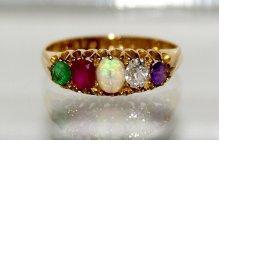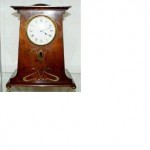By Jenny Johns
What do you do with the piece of china that your great aunt has left you or the table, inherited from your mother, that’s too large to fit into your new flat? You could advertise it for sale on ebay of course, but such pieces aren’t something you can easily arrange to deliver. You don’t just want to make a donation to a charity shop; you’d like to raise some money on the item so you could buy something that you would like and that would be a memento.
Your first step is to get a valuation, an approximate idea of what you might get for the piece if you sell it. Assuming you’re not going to join the queue for the Antiques Roadshow, your best route is to contact a reputable auctioneer.
DGS Auction Rooms is a family-run business in Hythe High Street. Alan and David’s father started this Hythe firm four years ago when he retired from running a similar operation for more than forty years in London. Alan didn’t follow his father into the family business originally, he’s a builder. Although a director of DGS, David lives and works abroad so it was left to Alan to step into the breach caused by his father’s stroke to keep the operation going. As he told me, ‘I grew up surrounded by the antiques and collectibles my Dad handled so I couldn’t help learning about them.’ As any expert will tell you, it’s the constant exposure to works of art, whether paintings, furniture, clocks, silver or china, that trains the eye. If you see similar objects on a daily basis, you develop an almost instinctive feel for the quality of an item.
Your first contact at DGS is most likely to be with Richard who’s in the auction room full time. He’s a prime example of learning by seeing. He started with the firm straight from school when the focus of his interest was coins. ‘My grandfather had quite a collection of coins and he used to tell me about them,’ he said. Richard’s interest fitted into his new job. DGA hold specialist coin auctions every three months and have an international reputation in this field. ‘Since working here, I’ve added Oriental ceramics and silver to coins and military items as things I’m interested in,’ Richard told me. ‘I’ve learned a lot by asking people about the items they bring in for sale. I’m even getting interested in paintings now, ’ he added, sounding a little surprised.
So, having made contact, your next question is going to be about your piece’s probable value. Setting an estimate for a lot is an important part of an auction house’s function. I asked Richard how he established this. ‘A lot of the time we can use past sale records,’ he said. ‘Then there are the reference books.’ He pointed to a pile of them on a shelf. ‘If we need to, we can research an item on the internet.’ I asked him if they used past sale prices from other auction houses. ‘Sometimes,’ he said. ‘But very often these can be difficult to get hold of for items other than paintings.’ So there you are. The estimated value of your piece will be based on a combination of recognition, knowledge and research.
You may decide that, based on this estimate, there’s a price below which you don’t want to sell – in other words, the reserve price. This is usually a percentage of the estimate and is noted in the auctioneer’s copy of the catalogue. That’s the first part of the process over. Your item has been accepted for sale, will be given a lot number for inclusion in the catalogue which will also show the estimated value, given as two figures – (for example £100 – £150) – and will be part of the next antiques and collectibles sale that DGS hold every two weeks. Most of the items that DGS sell come in from local people in this way.
DGS publicise their sales in the local paper, on line and, of course, they have a regular mailing list. You have nothing more to do but the staff at DGS now have to give every item a lot number, list it correctly under that number in the catalogue and find a place for it in the auction rooms. For the buyers’ benefit, it’s useful if similar pieces can be grouped together. For example, furniture items listed in consecutive order so that potential buyers know roughly when these pieces will be auctioned if furniture is their only interest in the sale.
Now you have to decide whether you’re going to attend the auction to see your lot sold. This can be an exciting or difficult experience. Many years ago, when I worked for Sotheby’s Canada, one lot was a large painting in a heavily ornate but fragile frame whose owner was sitting in the front row. As the porters lifted it on to the display easel some of the frame’s scrollwork broke off. The owner darted forward and gathered them up, uttering little squeaks of dismay as she did so. The first thing the new owner did, very sensibly, was to have the painting reframed!
Suppose when you took your piece to DGS you spotted an item in their showroom you’d like to buy, what do you need to do? First, have a good look at the piece from every angle and discuss the estimate with Richard or Alan. Then decide how much you’re prepared to pay for this lot. It’s almost always cheaper to buy at auction than from a dealer as the latter will mark up the auction price to cover his costs. You can usually spot the dealers by the number of items they buy. DGS charge a 15% commission to both seller and buyer as the means of covering their overheads. Interestingly, they make no extra charge for photography if they feature your item in their publicity.
If you can’t attend the auction, you can leave a bid with them. This again will be noted on the auctioneer’s copy of the catalogue. If you do attend the auction as a buyer – and many people just come to watch – you will be asked to register for a bidding number. DGS use laminated cards and ask you to show this to the auctioneer as you bid.
I asked Richard if they had ever been asked to accept secret bidding codes but neither Richard nor Alan remembered having to do this. These were frequently used at Sotheby’s Canada auctions. At one sale, of early Canadian photographs, two bidders had asked for secret bidding codes to be accepted. The first bidder was from the National Archives, an experienced auction goer, whose secret code was holding up his pen to show he was bidding. The second was an enthusiastic collector whose bidding code was to hold up his catalogue. By chance they sat next to one another. As the bids mounted on each item, the enthusiastic collector kept turning round, scanning the room to see if he could spot who his rival was. He never did, much to our amusement.
The auction at DGS of antiques and collectibles I attended on March 1st was Alan’s debut as auctioneer. Their regular auctioneer was unable to be there due to a conflicting arrangement. So on the dot of noon, Alan took his place behind the desk and opened the bidding on Lot 1, a set of 5 Executive blue leather meeting chairs.
Bidding is brisk at an auction: Alan averaged a lot a minute. Because the lots were scattered around the room, there was someone to go round and point out or hold up each item. I sat next to a couple who frequently bought at auction. They had their list of the items they were interested in and the maximum amount they were prepared to pay. If that maximum was passed, they were too experienced to get carried away and bid more than they had intended – a hazard of auction going if there’s a lot you’ve set your heart on! In front of us was a lady attending her very first auction. She was also interested in a particular piece and was thrilled when she was the successful bidder on it. Letting out a triumphant ‘Yes’ she also let slip that she would have been prepared to pay more if she had to. Naturally, Alan said she should have told him that earlier!
Alan used the phrase ‘On the book’ to let the room know when there was a written bid on an item, and also indicated when potential bidders hadn’t met the reserve. I’d asked Richard what happened to unsold items. ‘We put the items into two auctions,’ he told me. ‘Then, if they haven’t sold we ask the buyer to collect or, if they don’t want the piece back, we give it to a charity.’
At the March 1ST auction I noticed that the furniture lots sold well, within or above their estimate, as there were several bidders for many of the items. There was a selection of Oriental ceramics on which the bidding was very slow or non-existent. Alan didn’t waste time trying to cajole bidders, just passed on the item, ie, it was unsold. I asked Richard afterwards if, as these were specialist items, they would suggest to the owner putting them into a London auction. ‘The problem with that,’ he said, ‘is that houses like Bonham’s will only accept items with a minimum value of £500.’ This was a surprise to me as I hadn’t realised tthese major auction houses had that kind of criterion.
As the bidding on the items listed on each catalogue page is completed, the sheet was passed back to Richard. He had the task of collating the items for each bidder so their total spend was already calculated for them when they came to pay, along with the DGS commission. Buyers can choose whether they take the week to pay or pay and collect on the spot. If it’s a larger piece DGS will deliver it, for an extra charge. Alan’s son, Robert, helps Richard with these deliveries. At the March 1st auction, one bidder had bought a chair and wanted to take it away immediately, before the auction was over. No problem, except for the person who was sitting in the chair watching the auction!
DGS operate with a small number of permanent staff. Apart from Richard, Alan and Robert, there’s Sarah who handles the admin. When I spoke with her on my original visit, she told me it was only her second week in the job. ‘I’m finding it very new and interesting,’ she said. ‘Quite a change from my previous post as a legal secretary.’ It’s this small group of dedicated behind-the-scenes staff who make DGS auctions possible.
Rye’s Own May 2014
All articles, photographs and drawings on this web site are World Copyright Protected. No reproduction for publication without prior arrangement.


